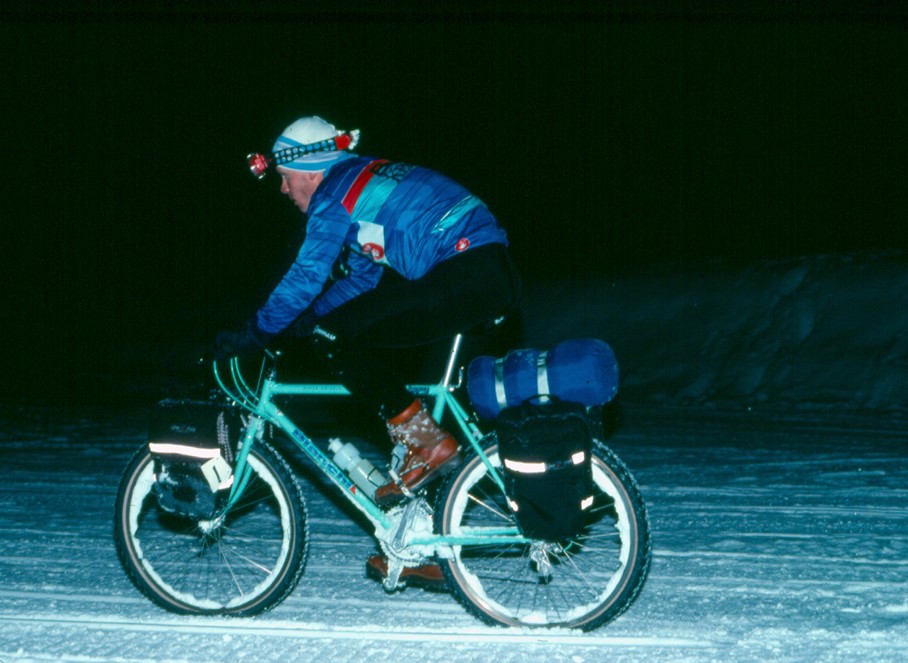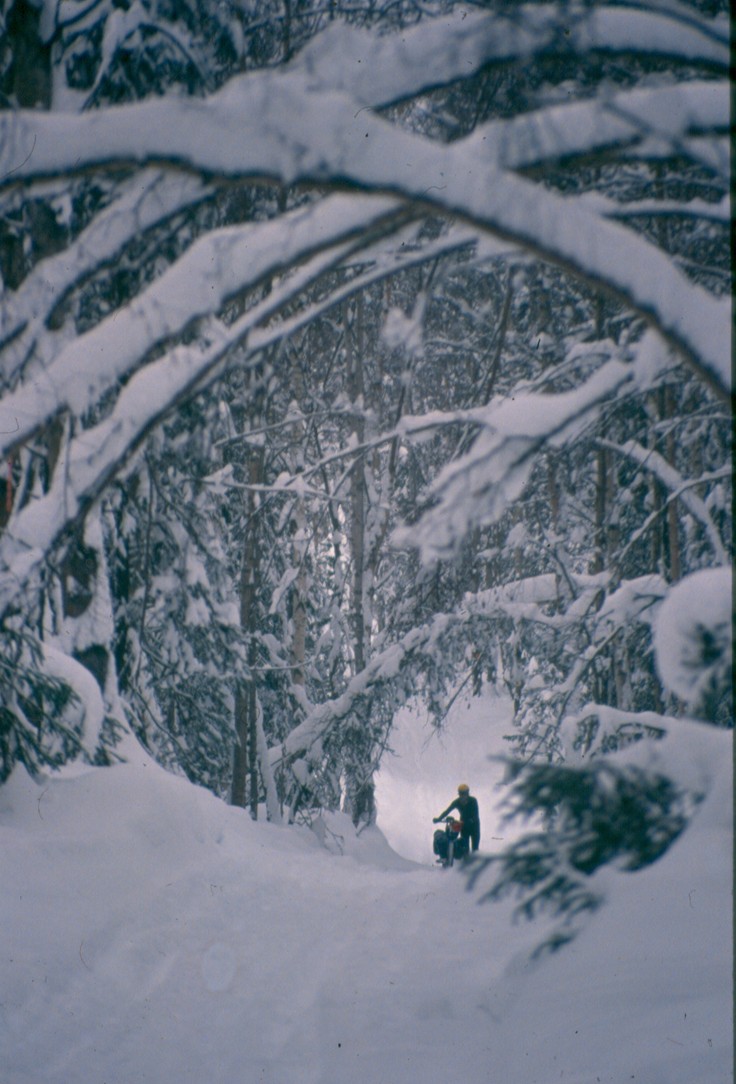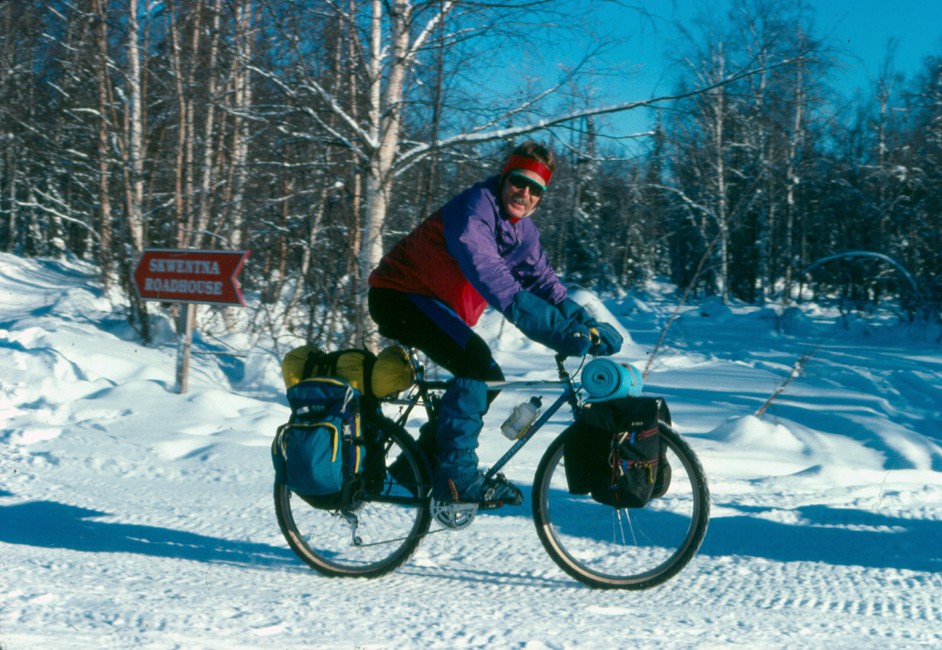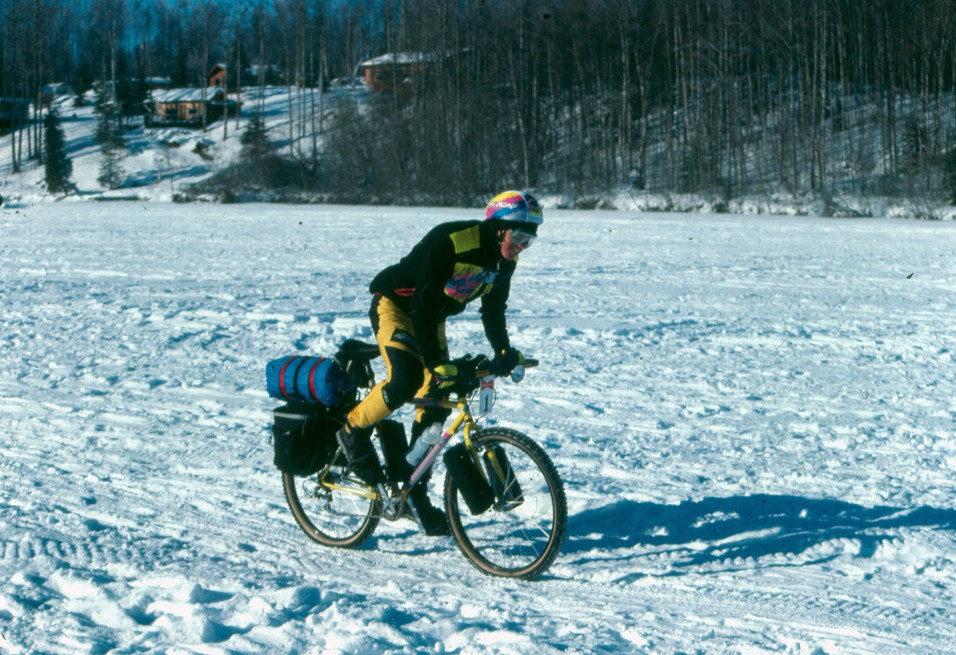|
Back to Reprints |
|
Home | Mountain Bikes | Fat Tire Flyer | Kelly Moving | APHIDS | Sons of Champlin | Reprints | Links |
|
This
story is about the first
IditaBike in 1987.
You are in Charlie Kelly's MOUNTAIN BIKE HUBSITE. Don't miss the MAIN PAGE. |
|
|
This piece ran in Cyclist Magazine. More Iditabike photos |
|
Dogsled? In Alaska? Who knew? |
|
Below: Don Cuerdon AKA
Captain Dondo at the Iditabike.
The Brotherhood of Pain: the First IditaBike
Skwentna, Alaska, 3:45 a.m. Dave Zink and Mike Kloser stumble in the door of the halfway checkpoint in the first "Iditabike" classic. Eighteen hours after the start of the race, they are the leaders.. They are also, as the saying goes, hating life. "I can't believe I just pushed my bike 70 miles through the snow," Kloser is saying. Kloser strips off his shoes and inspects a mildly frozen and bandaged big toe. "I froze this one skiing before, so it's a little more sensitive to cold. I'll live." Adding to their anguish is the fact that for the last hour and a half they have been within a mile of the checkpoint -- it's located in a one-room schoolhouse but having missed the sign in the darkness, they have been wandering around lost in a maze of snowmobile trails or riding up and down the airstrip plowed out of the deep snow. In a state known for extremes -- of cold, of distance and of athletic challenges -- the local mountain bikers have created a challenge that has been billed as "The Toughest Mountain Bike Race in tbe World." Considering that the distance is four times that of the race which had previously held that unofficial title, that the race is conducted in deep spow, and that the weather possibilites include blizzards and temperatures far below zero, no one is likely to argue the point. The "Iditabike" is the latest version of extreme sporting challenges loosely patterned after the 1100-mile Iditarod sled dog race, certainly the world's toughest athletic challenge for canines. Now there is the "Iditaski" cross-country race, and in 1986 70-year-old Joe Redington Sr., who dreamed up the lditarod 15 years ago, suggested to the Mountain Bikers of Alaska (MBA) that they race mountain bikes on the 21O-mile ski-race course which follows the lditarod Trail out of Knik for a hundred miles and returns. The kicker was that they should do it. in the winter, leaving the day after the dogsled race. The MBA accepted the challenge. "We don't have any idea what's going to happen, but we're willing to give this thing a try," said race organizer Dan Bull in a capsule description of the Alaskan attitude toward all of their ultra-events. A pre-race riders' meeting dwelled on some of the more - important hazards, principally hypothermia and frostbite. Riders were warned to beware of moose attacKs along a stretch called "Moose Alley." Bullwinkle? Hostile? Moose attacks are no joke; in the 1985 Iditarod one dogsledder had two dogs killed and a dozen injured by a moose.
Because no one had any way of knowing what would work on the long trail, secret weaponry was the order of the day and, given the opportunity, mountain bikers are a creative bunch. There were two basic theories as to carrying the gear; some towed sleds piled with supplies while others packed equipment on the bike in a standard touring configuration. The sleds were all devised by the riders, and no two were alike, although there were some repeated themes. In general they were towed by long poles attached either to the rack, the seat cluster, or the chainstay(s). The advantage to the sled is that you can carry a lot more gear than is convenient to pile on the bike, which means you can be pretty comfortable if you have to camp. The disadvantage to the sled is that this turned out to be a lot slower than the bikes with panniers packed with a minimal survival outfit. Since the temperature never dropped below zero during the race and there were no blizzards requiring extreme survival tactics, the lighter bikes were more effective, although organizers indicated that in future events they will check to see that gear is suitable for the most extreme weather. Mike Kloser chose to carry part of his gear in a backpack, and ironically, he may have lost the race for this reason alone. Most, though not all, chose studded tires-either normal tires hand-modified by the addition of sheet-metal screws or the new tungsten-studded "Blizzard" tires from IRC. Some of the hand-done tires were fearsome things, bristling with sharp quarter-inch-Iong steel spikes. Shoes were a most important subject, and riders reached absolutely no consensus, sporting a variety ranging from the heaviest-duty arctic boots to ordinary cycle touring shoes. One rider made his own from a pair of cleated football shoes, to which he added insulation, Look pedal cleats and gaiters that made them impervious to snow.
The extreme cold made helmets an option, since
riders were in more danger from heat loss and hypothermia than from
high-speed falls in the snow, and there are warmer types of headgear
than a helmet designed, among other things, for effective cooling.
Cloisonne pin from the second IditaBike
Race logistics presented a daunting challenge, since the checkpoints spread along a hundred miles of trail were accessible only by dogsled, snowmobile or aircraft. The plan included air re-supply water drops at several locations where short-wave operators kept the race officials up to date on riders checking through. A 20-pound re-supply allowance for each rider was to be flown to the halfway point at Skwentna, where riders would be required to rest for six hours. As soon as the small group pulled out of the starting line, accompanied by unanimous whooping and cheering from riders and spectators alike, "we don't know what's going to happen" -- in others words, Murphy's Law -- took effect. The plane that was scheduled to supply the Rabbit Lake checkpoint, as well as to ferry the small and panting group of journalists around, broke part of its skilanding gear on the takeoff for the first checkpoint, which meant that it couldn't land on the frozen lake. Without the water that was to be dropped there as well as the race officials themselves, the shortwave operator scrambled to cover more areas of responsibility, melting snow for drinking water and directing riders. Even though in Alaska every fourth adult has a pilot's license, planes were hard to come by on race day since most of those available were by then engaged, flying people over the lditarod itself. In fact, there were so many small planes over the course that some of the pilots who were available refused to enter the crowded airspace. Finally race officials rounded up a plane to take the journalism squad and some supplies to the halfway point at Skwentna. Because the plane was not ski-equipped, it could only land there, since this town of 150 persons had a snow-surfaced runway plowed out of the deep snow.
In addition to the problems with the aircraft, other unforeseen difficulties arose. Most of the riders had ridden in snow before, but never behind 60-odd dogsleds and their attached thousand dogs. The combination of the sleds, dogs and relatively high temperatures turned part of the trail into an unrideable mush of soft snow. The cyclists had not anticipated a recent innovation in dogsled design, a brake that churns up the snow and as a side effect renders downhills impossible for cyclists. The Iditabike leaders, two riders from the lower 48, covered the first 40 miles on packed trail at a ferocious pace, with Dave Zink leading Mike Kloser by a couple of minutes. Then their real troubles began. About 10 miles before the second checkpoint at Big Su the snow got too soft and too churned up to ride on. They kept going on in spite of the fact that they were now having to push their bikes through the treacherous powder. Surely, they thought, this would give way to the firm surface they had started on. All they had to do was reach the schoolhouse at Skwentna, 60 miles up the trail. The powder snow went on and on. Mark Frise, a fine cyclist but not a pedestrian, had stayed close to Zink and Kloser at first but lost time in the heavier going. Pushing his bike he developed a painful hip condition and dropped even further behind the leading pair. Discouraged, exhausted and alone, he started back toward the first checkpoint. Up ahead Zink and Kloser, formerly strangers to each other, were now hardly competing between themselves. Far more than two leaders in a road race forming a temporary union for strategic purposes, they forged a bond for survival, their united wills carrying them forward. The lditabike had become more than a bike race under tough conditions, and in the silent wonder of those clear subarctic nights, they joined in a brotherhood of pain. Committed to finish, they pushed their bikes an astonishing distance over the next 15 hours, although it was closer to 60 miles than the 70 they had estimated. Along the way they stopped occasionally to melt snow for water, to adjust clothing or just to marvel at the stillness and beauty of their surroundings. When one stopped, they both did. Finally, having endured the final blow of not being able to find the checkpoint in the darkness, they located the oasis of light, heat and food. Waiting for them was an enormous pot of hot moose stew, as well as fruit, bread, electrolyte replacements, and whatever nourishment they had chosen to pack into their permitted 20 pounds of airlifted gear. .. Due to the lack of airplane space, the checkpoint was staffed by only one official, Cheri Van Dyne. The four journalists in attendance became de facto participants, helping make signs to direct the riders, giving massages to frozen muscles and handing out the food. Also at the checkpoint was a longhaired and mustachioed individual named Roman Dial. An accomplished off-roader, he hadn't had the $100 entry fee but he didn't want to miss the event, so he had started with the racers but had turned off the course and used an easier route, riding on a snowmobile track on the frozen Yentna River. By doing so he had pulled into Skwentna several hours ahead of 'the race leaders, in time to have a beer and watch a videotaped movie at the roadhouse before they came in. Zink and Kloser were in low spirits from their exhausting efforts and the prospect of returning by the same trail. A spontaneous command decision was made to send racers back by the trail Dial had used. Another four riders pulled into the halfway point before the sun came up.
Three Alaskan riders came in together, Carl Tobin,
Mark Corson and Lee Matz. Then, in sixth place overall, Minnesota rider Martha Kennedy showed up, having pushed through the night alone. By the .time Zink and Kloser pulled out after their required six hours, the sun was up and their spirits had rebounded. After a huge breakfast of scrambled eggs and pancakes, they rolled down the airstrip toward the river with Roman Dial acting as guide until he broke a pedal not far from the finish. Their tracks would serve the others as trail markers. Elated by the faster riding they made excellent time, but as they neared the finish a new problem arose: somebody had to win. Kloser's sponsor, Fisher Mountain Bikes, had offered him a cash bonus if he won the race. Zink was unsponsored, but he hadn't come this far to take second place arbitrarily, and an agreed tie seemed unpalatable, since it was after all a race. They decided to sprint the length ofthe frozen Knik Lake to the finish, about 200 yards.
Below: Trail marking reflector from the Iditabike.
The finish line consisted of a banner hung between two poles set into twofoot-thick ice. Next to it in a motor home a small group of officials, a couple of girlfriends of riders, the shortwave operator and the ubiquitous journalists kept watch on the trail that descended the far shore. Just after sunset, while the sky was still bathed in the long northern twilight. . . "Two bikes! Two bikes!" A half dozen people rushed to the finish line to cheer the riders home. Near the far shore the two riders came out of their saddles, in the dim light impossible to tell apart. Almost 34 hours after they started, they would decide the contest' by a fraction of a second. Here Kloser's backpack was more of a hindrance than Zink's panniers were, or perhaps Mike just didn't have the strength, but the result was that Dave Zink crossed ahead by a clear bike length. The result was clear, but curiously neither of the riders was comfortable with it. Drinking a beer a few minutes later in the nearby Knik bar, Zink said, "Really, it was pretty much a tie. We had to stay together just to keep going. At the same time, Kloser, although obviously disappointed over the financial aspects of a couple of bike lengths out of 200 miles, said, "No, you won it. No one wants to see a tie." (Kloser's sponsor, Fisher Mountain Bikes, paid him in spite of the second-place finish.) Thirteen people finished the race, the last seven taking more than two days to complete the distance. The most serious casualty was Nels Johnson from La Crosse, Wisconsin, who suffered from frostbitten feet. Although Johnson is an experienced cold-weather rider, he checked his feet only because the checkpoint official suggested he do so and was alarmed to find parts of one foot blackened and frostbitten. Later he said that he had probably worn too many pairs of socks and impaired his circulation. Johnson was flown to a hospital with a mild case of frostbitten toes, and says he will be back next year. After turning back while in third position, Mark Frise had reversed his direction again and gone the distance, although he got badly lost and finished even further back than necessary. Martha Kennedy was one of the most impressive competitors, having completed the distance with none of the moral support of riders traveling together. She was the first woman across the line, finishing sixth overall, and still riding alone. Interestingly, she and Men's winner Zink are both from St. Paul, Minnesota and had trained together for the race. Those who finished, whatever their placings, are now members of an exclusive club with a painful initiation, and for these riders the First Iditabike will remain their most significant cycling achievement. No matter what shape the race takes in the future, only 13 people will be able to say, "I finished the first one."
|
Dave Zink



Mike Kloser

|
This article ran in the Anchorage newspaper before the first IditaBike. It gives me personal credit for the attendance of riders from the "Lower 48." |
|
|
|
|
|
Back to Top of Page |
Back to Reprints page |
|
Home | Mountain Bikes | Fat Tire Flyer | Kelly Moving | APHIDS | Sons of Champlin | Reprints | Links |
|
|